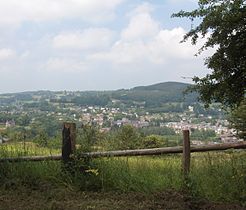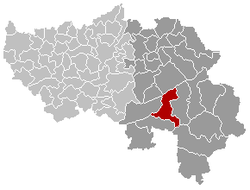Abbey of Stavelot
|
Stavelot Stablo (German) |
||
|---|---|---|
| Municipality | ||
 |
||
|
||
| Location in Belgium | ||
| Coordinates: 50°23′N 5°56′E / 50.383°N 5.933°ECoordinates: 50°23′N 5°56′E / 50.383°N 5.933°E | ||
| Country | Belgium | |
| Community | French Community | |
| Region | Wallonia | |
| Province | Liège | |
| Arrondissement | Verviers | |
| Government | ||
| • Mayor | Thierry de Bournonville | |
| Area | ||
| • Total | 85.07 km2 (32.85 sq mi) | |
| Population (1 January 2016) | ||
| • Total | 7,174 | |
| • Density | 84/km2 (220/sq mi) | |
| Postal codes | 4970 | |
| Area codes | 080 | |
| Website | www.stavelot.be | |
Stavelot (German: Stablo, Walloon: Ståvleu) is a Walloon municipality in the Belgian province of Liège. In 2006, Stavelot had a population of 6,671 and an area of 85.07 km2 (32.85 sq mi), giving a population density of 78 inhabitants per square kilometre (200/sq mi).
The town grew up around the Abbey of Stavelot, founded ca 650, out of what had been a villa, by Saint Remaclus (Saint Remacle). The villa's lands occupied the borderland between the bishoprics of Cologne and Tongeren. The Abbey of Stavelot was secularized and demolished at the time of the French Revolution: of the church just the west end doorway remains, as a free-standing tower. Two cloisters — one secular, one for the monks — survive as the courtyards of the brick-and-stone 17th-century domestic ranges, now housing the Museum of the Principality of Stavelot-Malmedy, and museums devoted to the poet Guillaume Apollinaire, who was a long-term resident, and to the Circuit de Spa-Francorchamps. The foundations of the abbey church are presented as a footprint, with walls and column bases that enable the visitor to visualize the scale of the Romanesque abbey.
Abbot Wibald (ruled 1130–58) was one of the greatest patrons of the arts in the 12th century; the Stavelot Triptych of gilded copper and enamels, which contained two fragments of the True Cross, was produced for the Abbey during his rule (about 1156). The binding of the Stavelot Bible, and the remaining fragments from the retable (altar screen) at Stavelot are also high points of medieval art.
In the 16th century, the monk Jean Delvaux claimed to have seen witches and demonic rituals, as he accused several other church officials of engaging in these rituals.
...
Wikipedia



